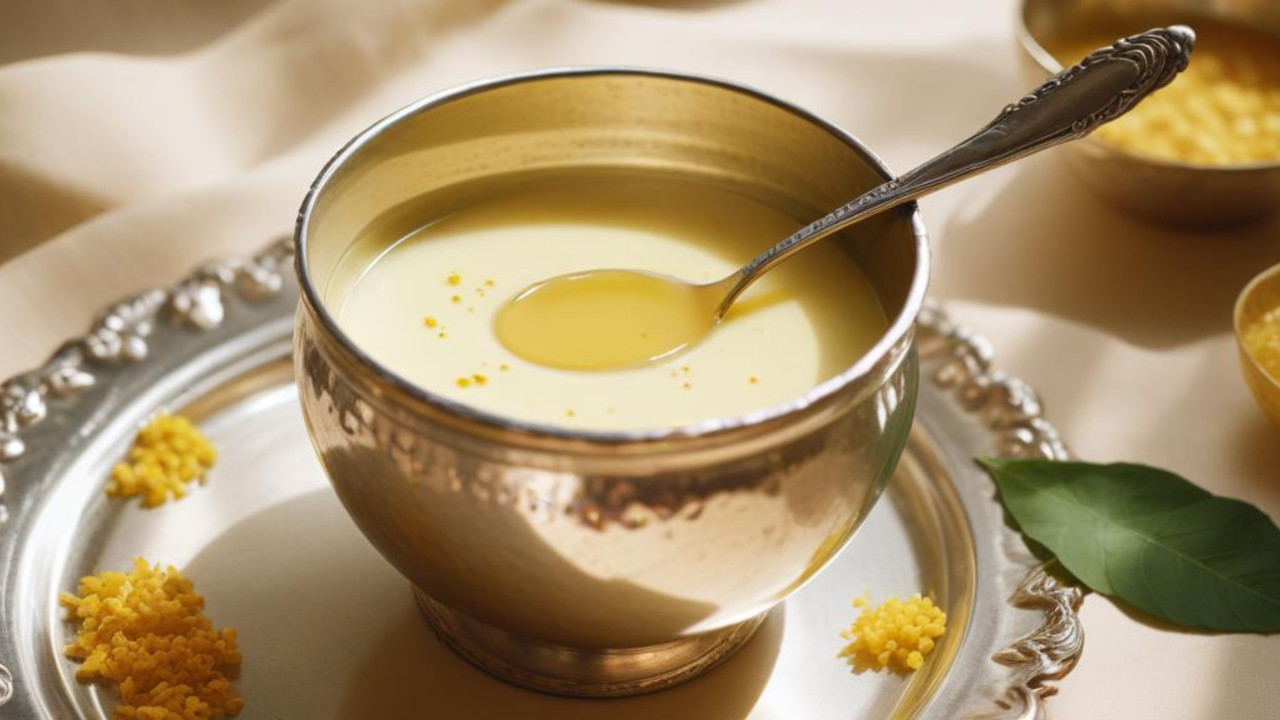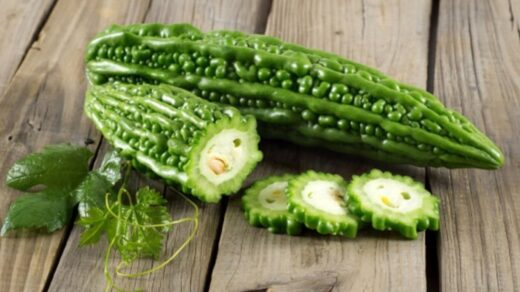Panchamrit: What Does Ayurveda Say About this Holy Drink?
Panchamrit is more than just a drink, a Sanskrit word meaning “five nectars,” is a divine offering in Hinduism. This blissful concoction, combining the earthy sweetness of honey with the tang of curd and the rich nuttiness of ghee in sweetened milk, lingers on the tongue long after the last sip.
It’s a taste that instantly transports me back to childhood poojas and family gatherings. Every spoonful brings back memories of rituals and the joy of celebrating with loved ones.
What is Panchamrit?
Panchamrit means “five nectars” (Pancha – five, Amrita – ambrosia), Panchamrit is a sacred Hindu drink made with five equal parts: milk, curd, honey, sugar, and ghee.
It’s a divine offering during pujas and abhishekams, and some regions even call it Charanamrit. Often, fragrant tulsi leaves and a sprinkle of dried fruits add a touch of devotion and richness to this symbolic concoction.
Panchamrit, also known as Panchamrutham, is an essential offering in Hindu religious rituals and ceremonies. The term “Panchamrit” is derived from two Sanskrit words: “Pancha,” meaning five, and “Amrut,” meaning the divine nectar of the gods or immortality.
Origins and Significance
According to the ancient epic Mahabharata, Panchamrit was one of the divine ingredients that emerged during the Samudra Manthan, also known as the Ksheera Sagar Manthan or the churning of the ocean of milk.
This event is a significant mythological story where gods and demons worked together to churn the ocean in search of Amrut, the nectar of immortality.
What is Panchamrit made of?
Panchamrit is a concoction made of five ingredients:
1. Milk – Symbolizes purity and piousness.
2. Honey – Produced by bees with absolute dedication and cooperation, symbolizing sweet speech and unity.
3. Curd (Yogurt) – Represents prosperity.
4. Sugar – Stands for sweetness and bliss.
5. Ghee (Clarified Butter) – Indicates strength and victory.
Symbolic Meanings of the Ingredients
Each ingredient in Panchamrit carries specific symbolic meanings:
- Milk: Represents purity and piousness, reflecting the spiritual cleanliness and sanctity of the ritual.
- Honey: Symbolizes sweet speech and unity, produced by bees with dedication and cooperation.
- Sugar: Signifies sweetness and bliss, bringing joy and positivity to the ritual.
- Curd: Indicates prosperity, representing abundance and wealth.
- Ghee: Stands for strength and victory, symbolizing the power and success bestowed upon the devotees.
Ritual Use
Panchamrit is used during Abhisheka, the ritualistic bathing of the deity. It is offered to the gods as a token of devotion and is also distributed among devotees as a blessed offering, believed to carry the divine essence of the gods.
This sacred mixture is considered a potent symbol of spiritual nourishment and divine blessing in Hindu worship practices.
In essence, Panchamrit is not only a sacred offering but also a representation of the virtues and qualities that devotees aspire to imbibe in their spiritual journey.
Health Benefits of Panchamrit
Beyond its religious significance, Panchamrit is revered in Ayurveda for its holistic health properties.
Combining the five ingredients in specific proportions is believed to nourish the body’s seven tissues (Sapt Dhatu), including bones, muscles, and the nervous system.
It’s said to balance Pitta Dosha (fire element), potentially improving immunity, brain function, and creativity. The beauty benefits extend to clear skin and healthy hair.
Additionally, some believe consuming Panchamrit during pregnancy can promote the well-being of both mother and fetus.
Key Health Benefits:
1. Balances Pitta Dosha: Panchamrit helps balance Pitta Dosha, one of the three doshas in the body, which is responsible for metabolic processes.
2. Improves Immunity: It enhances the body’s immune system, making it more resilient to diseases.
3. Enhances Brain Function: Panchamrit improves brain function, memory, and creative abilities.
4. Promotes Healthy Skin and Hair: It clears the complexion and keeps hair healthy.
5. Benefits During Pregnancy: Consuming Panchamrit during pregnancy boosts the health of both the mother and the fetus.
These health benefits make Panchamrit a revered part of Ayurvedic practice, valued not only for its spiritual significance but also for its contribution to overall well-being.
Health Benefits of Five Ingredients of Panchamrit
1. Milk
Panchamrit is traditionally made from cow’s milk. According to Ayurveda, cow’s milk has a cooling effect on the body and mind. It enhances Ojas, the essential energy responsible for a long, healthy life, radiance, strength, vitality, immunity, and mental and emotional wellness.
2. Curd
Curd or yogurt is the only fermented food recognized by Ayurveda as Sattvic, meaning it promotes purity and harmony. It is a probiotic that improves digestion and balances the Vata dosha, one of the three fundamental bodily humors in Ayurveda.
3. Honey
Ayurveda prescribes pure honey, as it contains all the necessary enzymes. Honey improves digestion, clears the complexion, and makes the skin smooth. It is easily digestible and assimilates into the bloodstream instantly when consumed. Honey is often used as an Anupan, a carrier, or a medium for Ayurvedic medicines.
4. Sugar
Sugar symbolizes sweetness and bliss. Ayurveda recommends candy sugar or Mishri, which is also used in many Ayurvedic formulas and churnas (medicinal powders). Candy sugar has a cooling effect on the body.
5. Ghee
Ghee is the most treasured food in Ayurveda, known for its remarkable healing properties for the body and mind. It is a good source of vitamins A and E and contains antioxidants that offer medicinal benefits.
Traditional Recipe for Panchamrit
Panchamrit, meaning “five nectars,” is a sacred offering in Hinduism made by combining five pure ingredients. Here’s a traditional recipe:
Ingredients:
- 1 tbsp Sugar
- 1 tbsp Honey (Note: Use slightly less honey than sugar)
- 1 tbsp Ghee (clarified butter)
- 1 tbsp Curd (yogurt)
- 7-8 tbsp Milk
- Tulsi leaves (holy basil)
Instructions:
- Ideally, use a silver bowl for its purported health benefits. Otherwise, a clean glass bowl works too.
- Add the sugar first, followed by honey.
- Next, add the curd and ghee.
- Finally, pour in the milk and mix everything well until thoroughly combined.
- Garnish with a few holy basil leaves (optional).
Frequently Asked Questions (FAQs) about Panchamrit
1. What is Panchamrit?
Panchamrit, also known as Panchamrutham, is a sacred mixture used in Hindu religious rituals. It consists of five key ingredients: milk, curd (yogurt), honey, sugar, and ghee.
2. Why is Panchamrit used in religious ceremonies?
Panchamrit is considered a divine offering to the deities and is used during Abhisheka (ritualistic bathing of the deity). It symbolizes purity, prosperity, unity, sweetness, and strength.
3. Can Panchamrit be consumed daily?
Yes, Panchamrit can be consumed daily. It is especially recommended during pregnancy for the health of both the mother and the fetus. Ayurveda suggests consuming it for its numerous health benefits.
4. How should Panchamrit be prepared?
Traditionally, Panchamrit is prepared in a silver bowl due to the metal’s antimicrobial and healing properties. The ingredients should be mixed in the right proportions to enhance their beneficial qualities.
5. Are there any regional variations of Panchamrit?
Yes, there are regional variations. In some places, basil leaves, dry fruits, and bananas are added to the mixture.
6. What is the shelf life of Panchamrit?
The shelf life of Panchamrit depends on the climate and season. During winter, it stays good for up to 12 hours, while in the summer, it can spoil within a few hours.
7. Can Panchamrit help during pregnancy?
Yes, Ayurveda recommends consuming Panchamrit for nine months during pregnancy as it boosts the health of both the mother and the fetus.
8. Is there anything to be cautious about when preparing Panchamrit?
According to Ayurveda, ghee and honey should never be mixed in equal quantities. It is important to ensure the correct proportions to avoid any adverse effects.
9. Can children consume Panchamrit?
Yes, children can consume Panchamrit. It provides essential nutrients and supports overall growth and development. However, it is advisable to consult an Ayurvedic practitioner for the appropriate dosage.
Panchamrit has numerous health benefits and, when combined in the right quantities, becomes extremely nourishing. You can enjoy Panchamrit even without having a puja at home.

























